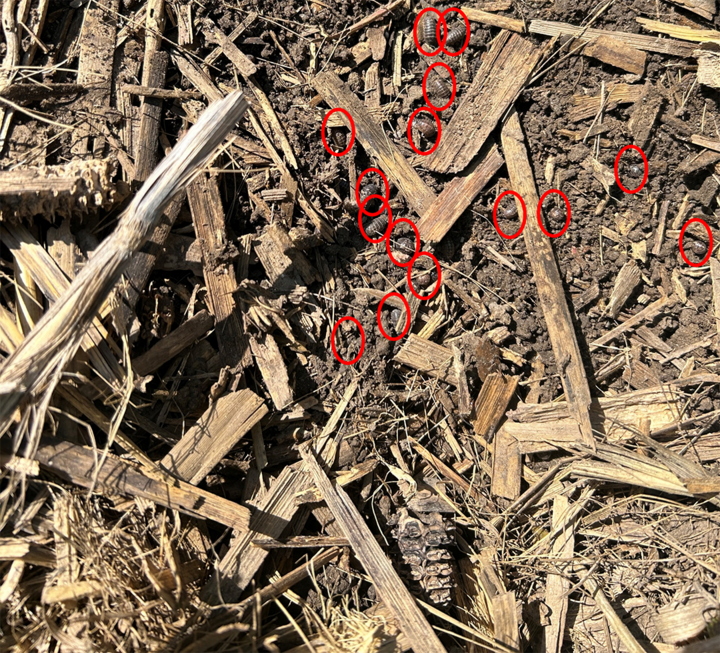Over the past week, pillbugs have been damaging soybean crops in some fields in southeastern, south-central and west-central Nebraska. Sporadic reports of pillbug injury to soybean crops have occurred in various parts of the state over the past several years, primarily in areas with heavy crop residue.
Pillbug injury to soybean is usually observed shortly after the plants emerge, with damage occurring to the hypocotyl — the part of the stem just below the cotyledonary node (Figure 1). Significant feeding on this part of the stem can result in plant death.

If this damage occurs frequently, replanting parts of the field may become necessary. Replanted fields are generally at less risk of pillbug injury due to the rapid germination and emergence of soybean plants. As temperatures rise and conditions become drier, the environment becomes less favorable for pillbugs, which require high humidity and moisture to thrive.
Pillbugs (Armadillidium vulgare), also known as roly polys, sowbugs, or woodlice, are native to Europe but have become widespread across North America and are now considered naturalized. As crustaceans, pillbugs are more closely related to shrimp than insects. They breathe through gills, making moist environments essential for their survival.
Pillbugs are wingless, hard-shelled, and grey to black in color, with seven pairs of legs. At maturity, they are about 3/8 of an inch long. Female pillbugs carry their eggs in a pouch on the underside of their bodies and continue to carry their young for a week after they hatch.

Management of pillbugs is challenging. While insecticide use as either a seed treatment or foliar application has been shown to cause pillbug mortality, stem injury and stand loss can still occur. Jeff Whitworth at Kansas State University indicated that for systemic neonicotinoids to cause mortality, a sufficient amount of the toxin must be ingested, which is unlikely to reduce damage to emerging plants.
A study by Johnson et al. in 2013 suggested that increasing plant populations from 148,000 to 296,000 plants per acre might help avoid the need for replanting. Growers facing replant decisions should plant at a normal population, as conditions in the next week or so should promote rapid growth and be less favorable for pillbugs. Before deciding to replant a field, refer to “Soybean Replanting Considerations” by Jenny Rees et al.
Several foliar products have been tested in Kansas, showing a significant reduction in pillbugs after application, though timing these applications to prevent significant injury and getting the product to the pests — which are often hidden under heavy residue (Figure 2) — remains challenging. Growers should be aware that the results from foliar applications have been mixed.
For cultural control, practices such as strip tillage, complete tillage, or burning crop residue may create a less hospitable environment for pillbugs but may not align with current agricultural practices. Crops also vary in their susceptibility to pillbugs, with corn being less susceptible than soybean, alfalfa, sunflower, wheat or oats.
If you have observed pillbugs causing injury to your soybean crop, please contact your local water and cropping systems extension educator to document and report the issue. Documenting the geography/location and extent of damage can help justify future research priorities.
